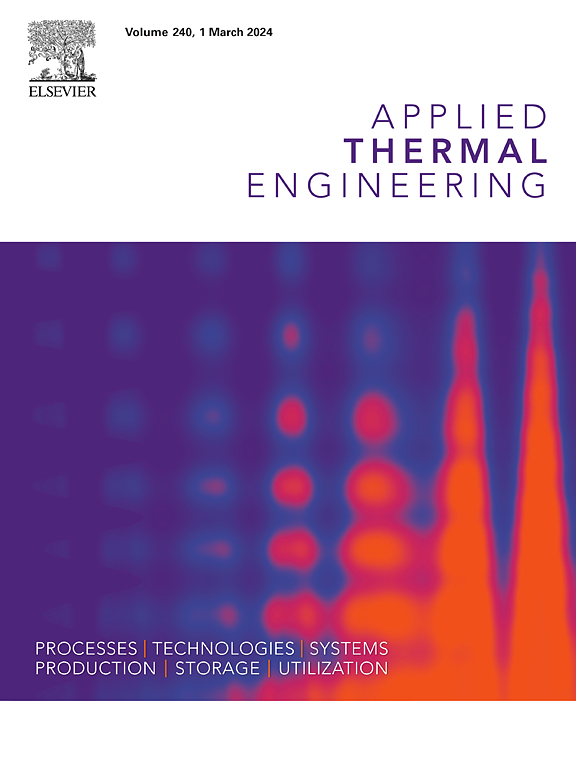涡轮叶片前缘低退化气膜冷却孔的几何优化
IF 6.9
2区 工程技术
Q2 ENERGY & FUELS
引用次数: 0
摘要
现有的涡轮叶片气膜冷却设计主要着眼于提高冷却效率,忽略了实际运行过程中性能的下降。这种疏忽会缩短使用寿命,导致设计可靠性不足。为了解决这一问题,采用共轭换热方法研究了膜孔几何偏差对前缘冷却效果的影响。提出了一种以降低冷却效果为目标的膜孔几何参数优化设计方法。利用Sobol敏感性分析,研究发现,孔径上偏对冷却效果和冷却性能的影响均占主导地位,分别占57.1%和70.2%。流动方向角和展向角的偏差较大时,显著简化了优化过程。衰减后,原叶片直径减小,膜发生反向流动。这导致冷却效率急剧下降,面积平均温度增加20.2 K。优化后,膜孔的设计直径提前减小,使衰减后的直径变化最小。通过优化角度,提高了膜的覆盖范围,达到了对冷却性能的补偿效果。在优化过程中,对内冷室总压进行监测,其绝对值始终小于2%。优化后的前缘冷却性能对几何偏差的敏感性降低,整体冷却效率衰减率降低了44%。采用优化方法,可对叶片设计进行微调,确保长期可靠运行。本文章由计算机程序翻译,如有差异,请以英文原文为准。
Geometric optimization for low-degradation film-cooling holes at the leading edge of turbine blades
Existing designs for film cooling of turbine blades mainly focus on higher cooling effectiveness, ignoring the performance degradation during actual operation. This oversight can reduce the lifespan and lead to insufficient design reliability. To handle this issue, the conjugate heat transfer method was employed to investigate the impact of geometric deviations of film holes on cooling effectiveness at the leading edge. An optimized design method for the geometric parameters of film holes, aimed at minimizing cooling effectiveness degradation, has been developed. Using Sobol sensitivity analysis, the study revealed that the upper deviation in the hole diameter had a dominant effect on both cooling effectiveness and its degradation, accounting for 57.1 % and 70.2 %, respectively. The deviation in flow direction angle and spanwise angle, when acute, significantly simplified the optimization process. After attenuation, the diameter of the original blade decreased, and the film experienced reverse flow. This led to a sharp reduction in cooling effectiveness, with the area-averaged temperature increasing by 20.2 K. Following optimization, the design diameter of the film holes was reduced in advance, leading to minimal changes in the diameter after attenuation. By optimizing the angles, the film coverage was improved, achieving a compensation effect on the cooling performance. During the optimization process, the total pressure of internal cooling chamber was monitored, and the absolute value was always less than 2 %. As a result of the optimization, the sensitivity of the leading-edge cooling performance to the geometric deviations was reduced, and the overall cooling effectiveness decay rate was lowered by 44 %. The optimization approach enables the fine-tuning of blade design, ensuring long-term reliable operation.
求助全文
通过发布文献求助,成功后即可免费获取论文全文。
去求助
来源期刊

Applied Thermal Engineering
工程技术-工程:机械
CiteScore
11.30
自引率
15.60%
发文量
1474
审稿时长
57 days
期刊介绍:
Applied Thermal Engineering disseminates novel research related to the design, development and demonstration of components, devices, equipment, technologies and systems involving thermal processes for the production, storage, utilization and conservation of energy, with a focus on engineering application.
The journal publishes high-quality and high-impact Original Research Articles, Review Articles, Short Communications and Letters to the Editor on cutting-edge innovations in research, and recent advances or issues of interest to the thermal engineering community.
 求助内容:
求助内容: 应助结果提醒方式:
应助结果提醒方式:


